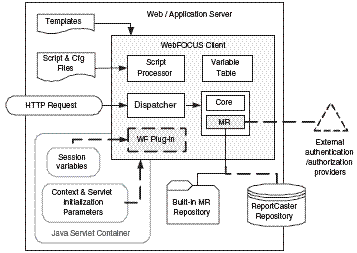
WebFOCUS has its own internal security model, encryption techniques, and variable table. Managed Reporting comes with its own repository for storing user credentials and access rights. However, WebFOCUS can be configured and extended to work with a wide variety of third-party products or customized solutions.
The following diagram illustrates the points in the WebFOCUS Client processing at which customization can be implemented.

The WebFOCUS Client has two points at which customized programs can be used to extend its default processing:
To use this plug-in, the customer site must perform some configuration steps, such as setting WebFOCUS variable values or editing properties. This plug-in provides methods for copying WebFOCUS variables, application server session variables, and HTTP header variables between the WebFOCUS variable table, the application server session, and the HTTP header. For instructions on using this plug-in, see Copying WebFOCUS Variables Using the WebFOCUS Servlet Plug-in.
If you require pre-processing or post-processing methods not included in the supplied plug-in or for the CGI implementation of the WebFOCUS Client, you can develop your own plug-in (you should extend the class for the existing plug-in so that you can still use its methods). A plug-in for the Servlet version of the WebFOCUS Client must be written in the Java™ language. A plug-in for the CGI version is typically written in the C language, but it can be written in any language that supports the creation of shared objects or dynamic link libraries. Instructions for writing WebFOCUS Servlet plug-ins can be found in Developing Your Own WebFOCUS Plug-in.
On the WebFOCUS Reporting Server, custom programs similar to WebFOCUS Client plug-ins are referred to as exits. The WebFOCUS Reporting Server has two exits that can be used by WebFOCUS:
| WebFOCUS |